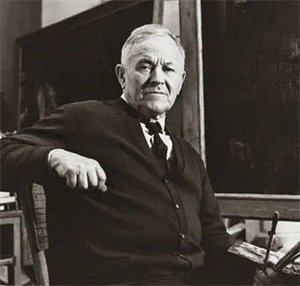Arkadi Aleksandrovich Plastov
Russian Socialist Realism
(Prislonikha, Simbirsk, Russia, 1893 – 1972, Prislonikha, Olyanovsk, Russia)
Arkadi Aleksandrovich Plastov was born in 1893 in the tiny village of Prislonikha to a family of peasants. His grandfather had been an icon painter. After 3 years at the local school, he entered the Simbirsk Spiritual Academy in 1903 and continued on into the Simbirsk Spiritual Seminary. But in 1912, he decided to study art and left for Moscow. He studied for a while in the studio of I. I. Mashkov and then entered the Stroganov Moscow State University of Arts and Industry. After that, he continued his studies in the sculpture department of the Moscow School of Painting, Sculpture, and Architecture. In 1917, he returned to his native village where he continued painting and working from nature until his death there in 1972. Plastov is called “the singer of Soviet peasantry” for his genre paintings of daily life in Soviet villages and collective farms. His earlier works have strong political undertones glorifying the work of collectivization but also bespeak the artist’s personal devotion to his own village and of his country in general. With the outbreak of World War II, the artist turned began to show the suffering of villagers, particularly women and the elderly who struggled on the collective farms without the help of the men who left to the front. The painting, “Spring”, is a turning point in Plastov’s work. It depicts a nude mother undressing her daughter to go to the banya, the Russian version of a sauna. Completed in 1954, a year after Stalin’s death, this picture is completely devoid of political messages and demonstrates the beginning of the Khruschev Thaw, a political movement which allowed artists more political freedom.
Russian Socialist Realism
(Prislonikha, Simbirsk, Russia, 1893 – 1972, Prislonikha, Olyanovsk, Russia)
Arkadi Aleksandrovich Plastov was born in 1893 in the tiny village of Prislonikha to a family of peasants. His grandfather had been an icon painter. After 3 years at the local school, he entered the Simbirsk Spiritual Academy in 1903 and continued on into the Simbirsk Spiritual Seminary. But in 1912, he decided to study art and left for Moscow. He studied for a while in the studio of I. I. Mashkov and then entered the Stroganov Moscow State University of Arts and Industry. After that, he continued his studies in the sculpture department of the Moscow School of Painting, Sculpture, and Architecture. In 1917, he returned to his native village where he continued painting and working from nature until his death there in 1972. Plastov is called “the singer of Soviet peasantry” for his genre paintings of daily life in Soviet villages and collective farms. His earlier works have strong political undertones glorifying the work of collectivization but also bespeak the artist’s personal devotion to his own village and of his country in general. With the outbreak of World War II, the artist turned began to show the suffering of villagers, particularly women and the elderly who struggled on the collective farms without the help of the men who left to the front. The painting, “Spring”, is a turning point in Plastov’s work. It depicts a nude mother undressing her daughter to go to the banya, the Russian version of a sauna. Completed in 1954, a year after Stalin’s death, this picture is completely devoid of political messages and demonstrates the beginning of the Khruschev Thaw, a political movement which allowed artists more political freedom.


